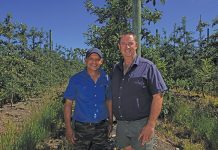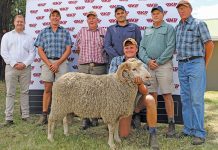Scientists have boosted the virus resistance of what could be a major floricultural crop with GMO technology, but out-of-lab trials are on hold for now. Lloyd Phillips reports.
The biotechnology division of the Agricultural Research Council’s Vegetable and Ornamental Plant Institute (ARC-VOPI), together with plant nursery Afriflowers, recently applied to conduct outdoor trials with the genetically modified flower hybrid Ornithogalum dubium x thyrsoides. However, the request was turned down by the executive committee of the GMO Act.
The stakeholders in the trial say they’ll reapply once they have all the safety information required for approval. A popular cut flower C ommonly known as chincherinchee or Star-of-Bethlehem, Ornithogalum is a bulbous plant belonging to the family Hyacinthaceae. Its long-lasting white, yellow and orange flowers have made it popular. “Ornithogalum is of great importance to the South African cut flower and pot plant industry,” says Gurling Bothma of ARC-VOPI. “We feel this hybrid can contribute significantly to the South African horticultural industry.” ARC-VOPI has genetically modified this hybrid to introduce resistance to the Ornithogalum mosaic virus (OMV), using Agrobacterium tumefaciens-mediated transformation. “is one of the major constraints on Ornithogalum production and there’s no natural resistance to this virus,” Bothma explains. “The modified plants express a portion of the virus coat protein (or replicase gene), conferring resistance to OMV.” The modified plants were to be tested at Afriflowers’ outdoor facilities. Their personnel are experienced cultivators of Ornithogalum and other floricultural crops.
Tests and trials
According to Bothma the effect of the inserted genes on flower and bulb morphology needs to be evaluated, and the inheritability of the inserted gene assessed. “Tests in a contained environment have shown significant resistance,” continues. “Now the plant has to demonstrate resistance under normal cultivation conditions.” H e added that this could only be done under more extensive trial conditions. It must also be determined whether the plants still grow like the original mother material. According to Bothma, two main Ornithogalum species are cultivated commercially, namely O. thyrsoides and O. dubium.
During the 1970s, breeding programmes were initiated at the ARC-VOPI to improve the phenotypic characteristics of various Ornithogalum breeding lines, focusing on long vase-life for flowers and tall, straight stems. “One hybrid, known as line A2, produces tall, straight stems and flamboyant yellow flowers. It has very good market characteristics, but is highly susceptible to OMV,” explains Bothma. “OMV is a typical, but distinct, potyvirus transmitted by aphids. Infections have been documented in the US, the Netherlands and South Africa.” Crucial disease control B othma says the control of OMV is crucial for the successful commercialisation of Ornithogalum.
Since the genus Ornithogalum has no resistance to OMV, genetic manipulation is the only way to confer it. The ARC-VOPI introduced virus resistance using coat protein (CP)-mediated resistance and replicase-mediated resistance. According to Bothma, CP-mediated resistance is based on the accumulation of coat protein. This confers resistance to the virus from which the CP gene has been derived and to related viruses, or hampers disease development. Contact Gurling Bothma on (012) 841 9611/9771, fax (012) 808 1499, or e-mail [email protected].








